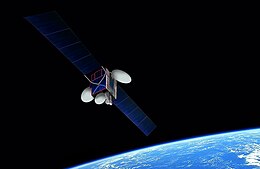 Artist impression of ABS-3 in orbit | |
| Names | Agila-2 (1997–2009) ABS-5 (2009–2011) ABS-3 (2011–present) |
|---|---|
| Mission type | Communications |
| Operator | Mabuhay (1997–2009) ABS (2009–present) |
| COSPAR ID | 1997-042A |
| SATCAT no. | 24901 |
| Mission duration | 15 years planned |
| Spacecraft properties | |
| Bus | LS-1300 |
| Manufacturer | Space Systems/Loral |
| Launch mass | 2,820 kilograms (6,220 lb) |
| Start of mission | |
| Launch date | August 19, 1997, 17:50 UTC[1] |
| Rocket | Chang Zheng 3B |
| Launch site | Xichang 2 |
| Orbital parameters | |
| Reference system | Geocentric |
| Regime | Geostationary |
ABS-3, formerly ABS-5, was initially named Agila 2 after the Philippine eagle,[2] before being acquired by ABS (formerly known as Asia Broadcast Satellite). Launched in 1997, the satellite provided telecommunications services for Mabuhay Satellite Corporation before being sold to ABS in 2009. Built by Space Systems/Loral, the satellite provided coverage in the Asia-Pacific region. Its control station is located at the Subic Bay Freeport Zone in the Philippines. The satellite was launched by Long March 3B and positioned at 146°E longitude.[3]
While it was the first Filipino-owned satellite to be launched into space, it isn't the first Filipino satellite. Another satellite named Mabuhay, previously known as Palapa B-2P, was acquired from Indonesian company Pasifik Satelit Nusantara a year earlier, becoming the first satellite owned by a Filipino entity.[4]
In 2011,[5] ABS-5 was renamed ABS-3 and repositioned to the 3°W orbital slot. ABS-3A was launched on 1 March 2015 to replace ABS-3,[6] which was relocated to operate at 15.75 WL and later at 85.3EL. In August 2017, ABS-3 was deorbited from the geostationary arc and retired after nearly 20 years of operation.
- ^ McDowell, Jonathan. "Launch Log". Jonathan's Space Page. Retrieved 6 July 2014.
- ^ "Agila 2". Archived from the original on 2009-02-09. Retrieved 2009-01-26.
- ^ "Jonathan's Space Report No. 331". Archived from the original on 2009-08-08. Retrieved 2009-02-02.
- ^ "Mabuhay acquires Indon satellite;sets new orbit". Manila Standard. July 25, 1996. Retrieved March 6, 2015.
- ^ "Agila 2 / ABS 5 → ABS 3". space.skyrocket.de. Retrieved 2018-01-25.
- ^ Graham, William (1 March 2015). "SpaceX Falcon 9 launches debut dual satellite mission". NASA SpaceFlight. Retrieved 28 September 2015.